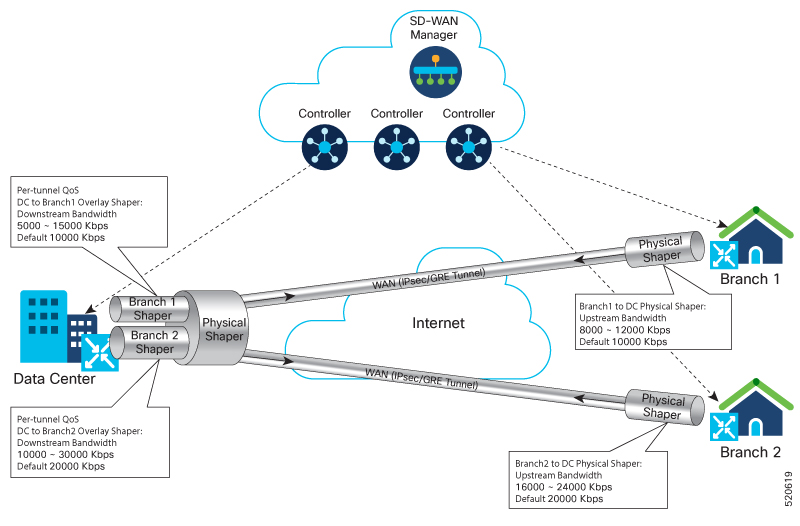Verify Upstream Configuration
The following sample output shows the adaptive QoS statistics collected for upstream traffic.
Device# show platform software sdwan qos adapt stats
INTERFACE DEFAULT MIN MAX PERD SHAPE-RATE
(kbps) (kbps) (kbps) (min) (kbps)
GigabitEthernet0/0/4 20000 10000 40000 1 40000
This sample output shows upstream adaptive QoS statistics.
Device# show platform software sdwan qos adapt history all
SDWAN upstream adaptive QoS
Interface: GigabitEthernet3
Adaptive QoS History:
TIME LOCAL-LOSS WAN-LOSS TOTAL-OFFER THROUGHPUT ADAPT SHAPE-RATE
(pps) (kbps) (kbps)
2020-06-08T07:49:46 0.0% 0.0% 9600 13827 NOPE 50000
2020-06-08T07:48:46 0.0% 0.0% 9600 13826 NOPE 50000
2020-06-08T07:47:46 0.0% 0.0% 9600 13825 NOPE 50000
2020-06-08T07:46:46 0.0% 0.0% 9600 13827 NOPE 50000
2020-06-08T07:45:46 0.0% 0.0% 9600 13828 NOPE 50000
2020-06-08T07:44:46 0.0% 0.0% 9600 13828 NOPE 50000
2020-06-08T07:43:46 0.0% 0.0% 9600 13827 NOPE 50000
2020-06-08T07:42:46 0.0% 0.0% 9600 13832 NOPE 50000
SDWAN upstream adaptive QoS
Interface: Loopback0
Adaptive QoS History:
TIME LOCAL-LOSS WAN-LOSS TOTAL-OFFER THROUGHPUT ADAPT SHAPE-RATE
(pps) (kbps) (kbps)
2020-06-08T07:49:46 50.8% 0.0% 16282 7980 UP 8099
2020-06-08T07:48:46 50.2% 0.8% 16282 8073 DOWN 8019
2020-06-08T07:47:46 50.8% 0.0% 16287 8005 UP 8099
2020-06-08T07:46:46 50.4% 0.7% 16282 8056 DOWN 8019
2020-06-08T07:45:46 50.9% 0.0% 16282 7976 UP 8099
2020-06-08T07:44:46 50.2% 0.9% 16282 8084 DOWN 8019
2020-06-08T07:43:46 50.7% 0.1% 16282 8002 UP 8099
2020-06-08T07:42:46 50.2% 0.9% 16282 8083 DOWN 8019
This sample output shows the history of the upstream adaptive QoS for the specified interface.
Device# show platform software sdwan qos adapt history GigabitEthernet0/0/4
SDWAN upstream adaptive QoS
Interface: GigabitEthernet0/0/4
Adaptive QoS History:
TIME LOCAL-LOSS WAN-LOSS TOTAL-OFFER THROUGHPUT ADAPT SHAPE-RATE
(pps) (kbps) (kbps)
2020-05-21T02:43:44 56.0% 0.0% 34952 22087 UP 25100
2020-05-21T02:42:44 62.0% 0.0% 34952 19089 UP 22100
2020-05-21T02:41:44 67.9% 0.0% 34952 16091 UP 19100
2020-05-21T02:40:44 73.9% 0.0% 34952 13091 UP 16100
2020-05-21T02:39:44 79.9% 0.0% 34952 10091 UP 13100
2020-05-21T02:38:44 80.1% 0.0% 34952 9990 UP 10100
2020-05-21T02:37:44 80.1% 29.4% 34952 9990 DOWN 10000
2020-05-21T02:36:44 80.1% 29.4% 34952 9990 DOWN 10000
The following sample output shows the verification of the adaptive QoS configuration in the policy map applied to the GigabitEthernet3
interface.
Device# show policy-map interface GigabitEthernet3
Service-policy output: shape_GigabitEthernet3
Class-map: class-default (match-any)
89140978 packets, 16580958431 bytes
30 second offered rate 23246000 bps, drop rate 5255000 bps
Match: any
Queueing
queue limit 83 packets
(queue depth/total drops/no-buffer drops) 0/25186569/0
(pkts output/bytes output) 73636046/13696793305
shape (average) cir 20143000, bc 80572, be 80572
target shape rate 20143000
Service-policy : qos_policy_4class_cedge
queue stats for all priority classes:
Queueing
priority level 1
queue limit 512 packets
(queue depth/total drops/no-buffer drops) 0/0/0
(pkts output/bytes output) 2004810/373383409
Class-map: Critical (match-any)
6566981 packets, 1222194617 bytes
30 second offered rate 13000 bps, drop rate 0000 bps
Match: qos-group 0
Priority: Strict, b/w exceed drops: 0
Priority Level: 1
Verify Downstream Configuration
The following sample output shows the downstream adaptive QoS configuration.
Device# show sdwan omp tlocs
---------------------------------------------------
tloc entries for 10.6.0.3
lte
ipsec
---------------------------------------------------
RECEIVED FROM:
peer 10.8.3.3
status C,I,R
loss-reason not set
lost-to-peer not set
lost-to-path-id not set
Attributes:
attribute-type installed
encap-key not set
encap-proto 0
encap-spi 261
encap-auth sha1-hmac,ah-sha1-hmac
encap-encrypt aes256
public-ip 176.16.6.2
public-port 12346
private-ip 176.16.6.2
private-port 12346
public-ip 176:16:6::2
public-port 12346
private-ip 176:16:6::2
private-port 12346
bfd-status up
domain-id not set
site-id 601
overlay-id not set
preference 1000
tag not set
stale not set
weight 1
version 3
gen-id 0x8000012c
carrier carrier6
restrict 0
on-demand 0
groups [ 0 ]
bandwidth 80000
bandwidth-dmin 50000
bandwidth-down 100000
bandwidth-dmax 100000
adapt-qos-period 15
adapt-qos-up 1
qos-group default-group
border not set
unknown-attr-len not set
The following sample output shows downstream adaptive QoS statistics.
Device# show platform software sdwan qos adapt stats
================= Adaptive QoS Stats =================
COLOR DEST-TLOC DEST-IP DEST-PORT ENCAP DEFAULT MIN MAX PERD SHAPE-RATE
(kbps) (kbps) (kbps) (min)(kbps)
lte 172.16.255.11 10.0.5.11 12347 IPSEC 100000 50000 100000 1 100000
lte 172.16.255.14 10.1.14.14 12346 IPSEC 100000 50000 100000 1 100000
The following sample output shows the adaptive QoS history of the eight most recent sessions on the tunnel.
Device# show platform software sdwan qos adapt history Tunnel1 10.1.14.14
SDWAN OMP Session
Color: lte
Dest Tloc: 172.16.255.14
Dest IP: 10.1.14.14
Dest Port: 12346
Encap: IPSEC
Adaptive QoS History:
TIME LOCAL-LOSS WAN-LOSS TOTAL-OFFER THROUGHPUT ADAPT SHAPE-RATE
(pps) (kbps) (kbps)
2020-05-21T04:51:28 30.0% 0.4% 87380 87852 DOWN 86973
2020-05-21T04:50:28 28.0% 2.9% 87380 90481 DOWN 87851
2020-05-21T04:49:28 31.9% 0.0% 87380 85553 UP 90474
2020-05-21T04:48:28 35.9% 0.0% 87380 80477 UP 85474
2020-05-21T04:47:28 39.9% 0.0% 87380 75475 UP 80474
2020-05-21T04:46:28 40.5% 0.0% 87380 74727 UP 75474
2020-05-21T04:45:28 39.9% 0.6% 87380 75480 DOWN 74727
2020-05-21T04:44:28 40.5% 0.0% 87380 74737 UP 75481
The following sample output shows the average shaper rate, target shaper rate, and the bandwidth remaining.
Device# show policy-map multipoint Tunnel1 10.1.14.14
Interface Tunnel1 <--> 10.1.14.14
Service-policy output: SDWANPolicy4325397
Class-map: class-default (match-any)
343994858 packets, 59167000300 bytes
5 minute offered rate 114034000 bps, drop rate 37596000 bps
Match: any
Queueing
queue limit 362 packets
(queue depth/total drops/no-buffer drops) 0/76866318/0
(pkts output/bytes output) 246459053/45841211875
shape (average) cir 87966000, bc 351864, be 351864
target shape rate 87966000
bandwidth remaining ratio 8
Service-policy : qos_policy_4class_cedge
queue stats for all priority classes:
Queueing
priority level 1
queue limit 512 packets
(queue depth/total drops/no-buffer drops) 0/0/0
(pkts output/bytes output) 40145494/7466889901
Class-map: Critical (match-any)
68807464 packets, 11834768360 bytes
5 minute offered rate 22815000 bps, drop rate 10139000 bps
Match: qos-group 0
Priority: Strict, b/w exceed drops: 0
Priority Level: 1
police:
rate 15 %
rate 13065500 bps, burst 408296 bytes
conformed 40141805 packets, 6904295187 bytes; actions: transmit


 Feedback
Feedback